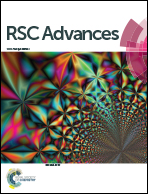Theoretical and experimental investigation of the polyeletrophilic β-enamino diketone: straightforward and highly regioselective synthesis of 1,4,5-trisubstituted pyrazoles and pyrazolo[3,4-d]pyridazinones†
Abstract
Obtaining a new precursor enamino diketone with five electrophilic centers is reported, along with theoretical and experimental studies of its reactivity against mono- or dinucleophiles. The Fukui function showed that the β-carbon is the most electrophilic center, followed by the carbonyl ketone and the carbonyl ester, respectively. The reaction of enamino diketone with aniline and hydrazines allowed for the synthesis of a new enamino diketone and 1,4-disubstituted pyrazoles-5-carboxylates, respectively. The regiochemistry and mechanism of syntheses of 1,4-disubstituted pyrazoles-5-carboxylates were determined from reaction monitoring by ESI-MS, NMR analysis and crystallographic data, and fully agreed with the theoretical results. The versatility and efficiency of the enamino diketone was demonstrated by the reaction with hydrazines furnishing multi-functionalized pyrazoles and pyrazolo[3,4-d]pyridazinone derivatives with high regioselectivity.
![Graphical abstract: Theoretical and experimental investigation of the polyeletrophilic β-enamino diketone: straightforward and highly regioselective synthesis of 1,4,5-trisubstituted pyrazoles and pyrazolo[3,4-d]pyridazinones](/en/Image/Get?imageInfo.ImageType=GA&imageInfo.ImageIdentifier.ManuscriptID=C5RA12968K&imageInfo.ImageIdentifier.Year=2016)

 Please wait while we load your content...
Please wait while we load your content...